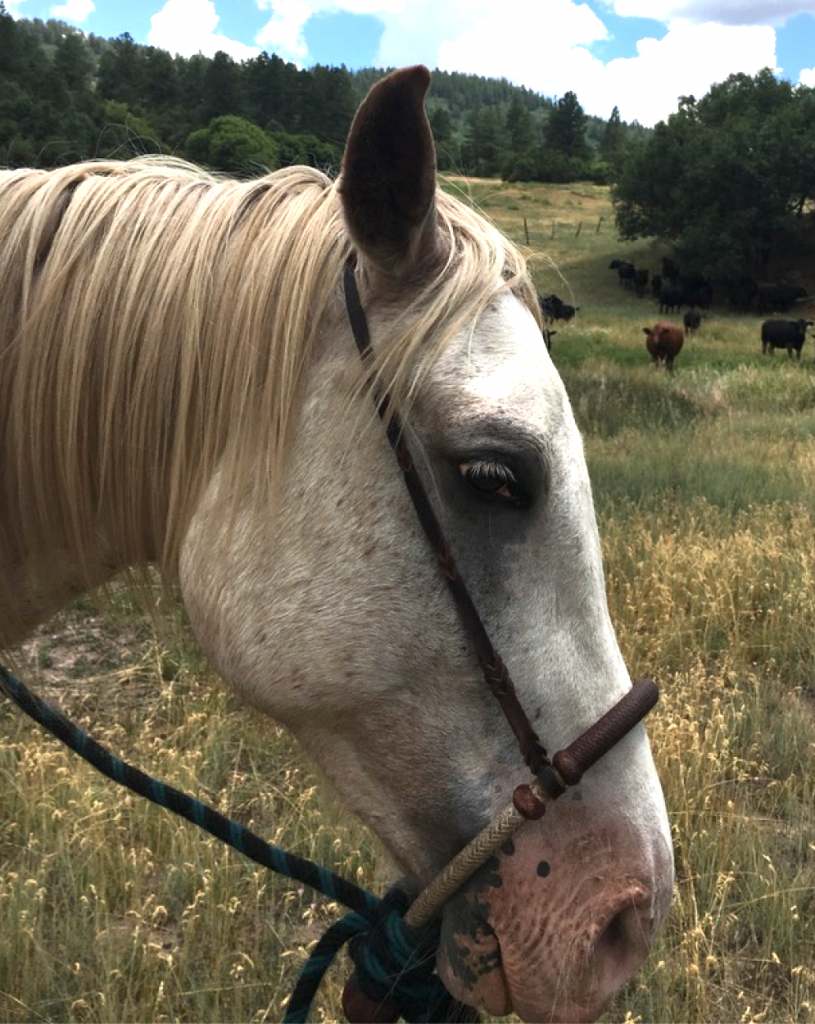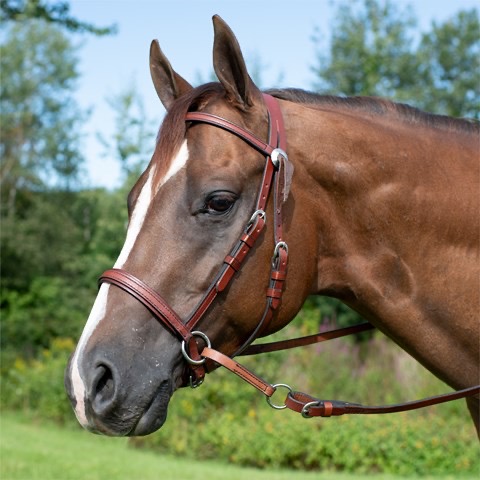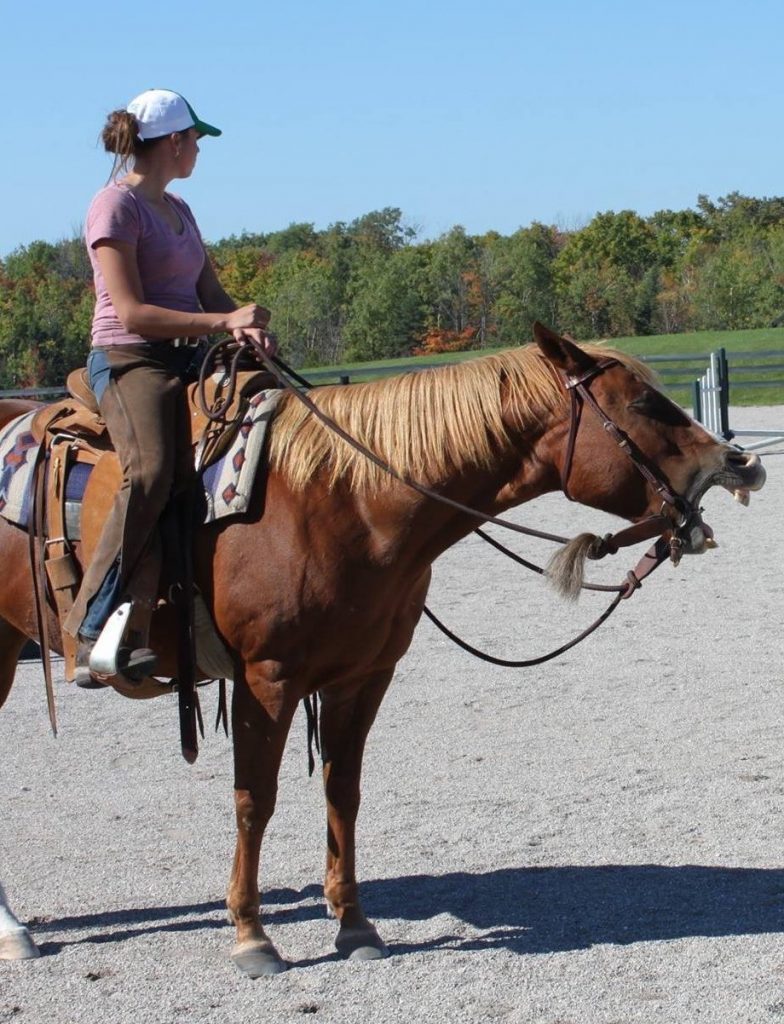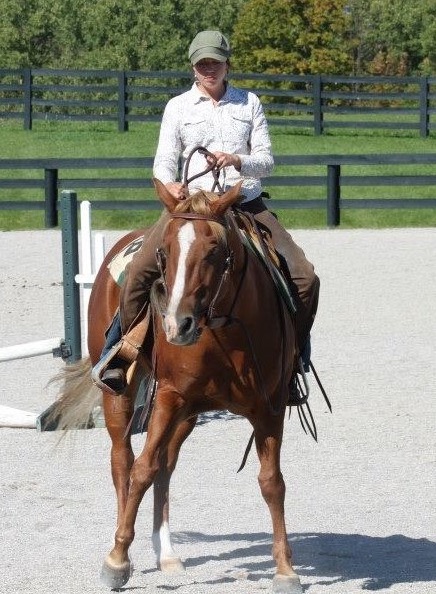Editor’s Note: Amy Skinner is a regular Cayuse columnist and has been a horse gal since age six. She presented with fellow trainer and rider, Katrin Silva, at the Best Horse Practices Summit.
Skinner rides and teaches dressage and Western. Skinner has studied at the Royal Andalusian School of Equestrian Art in Spain, with Buck Brannaman, Leslie Desmond, Brent Graef, and many others. Visit Amy’s website here.
Buy her new book, To Catch A Horse here.

Before you set up your horse in a hackamore, make sure you are both educated to it.
Amy Skinner writes:
Often when teaching, I meet folks who say their horses don’t like the bit. I’d like to propose that most horses can learn to like the bit just fine. What they don’t like is the way it is used or the way it fits.
In encounters with thousands of training horses, I’ve only come across two who couldn’t be ridden with a bit. One previously had been badly harmed by a severe bit and had anxiety about bits in general. The other had a mouth deformity that made wearing a bit very uncomfortable.
Riders who say their horses don’t like bits will have their horses in hackamores or bitless bridles. Going bitless isn’t bad. I’m a fan of hackamores and a few types of bitless bridles.
But it’s important to note that just removing the bit doesn’t automatically solve the problem. If the reins are not connected to the feet, and if the equipment doesn’t fit correctly or isn’t used correctly, and if the riders’ hands are uneducated or impatient, no type of equipment can protect a horse from discomfort. Bitless bridles, especially hackamores, can cause very severe pressure on a horse’s delicate facial nerves.

Dr. Cook bitless bridle
I have most horses in a snaffle bits and have found this to be an effective bit for clients to use. Why? In a snaffle bit, a horse can protect themselves from a rider’s poor feel in several ways:
- by bracing against the bit with their tongue, a very thick muscle
- by putting their head in the air to avoid contact
- by bringing their head toward their chest to avoid contact
- by grabbing the bit with their teeth
If the feel is offensive or if they don’t understand what to do with it, a horse has strategies and can avoid the bit or protect themselves from bad contact. But in a bitless bridle, halter, hackamore, or other type of headgear without a bit, the horse may have a harder time escaping that pressure on its face. The lack of a bit does not automatically mean “nicer” or softer feeling to the horse.

Amy’s horse, Dee, relaxes during a clinic. She is wearing a snaffle bit.
Furthermore, many bitless bridle designs are confusing to a horse. Without being educated to understand the meaning of a hackamore, horses struggle to follow the feel of it. This is especially problematic in the hands of an undereducated rider. Unlike a snaffle bit which applies direct pressure in the direction the rider hopes the horse will go, a hackamore is felt on the opposite side of the face and on the bridge of the nose. If a rider pulls the right rein, the hackamore is felt on the left side of the face. This is why the device requires more education on behalf of the rider, followed by more education on behalf of the horse.
Some bitless bridles, such as the Dr. Cook, have leather pieces crossing under the chin and connecting to the reins. When a rider pulls the left rein, the horse is feeling that pressure from the right side of the face and underneath the chin. Sometimes, this results in a head tilt. I’ll see a horse’s entire head become crooked (not just a tipped nose) to the outside of a turn. Obviously, this can be detrimental to his body alignment.
A snaffle bit is my favorite bit for most horses and riders because, if used correctly, it’s simple and mild. The snaffle is more forgiving of mistakes and has an easier feel to follow. It works directly: if the rider pulls the right rein, the horse feels that pressure on the right side of their mouth. When he turns right, that pressure is relieved. Of course, a rider can cause pain misusing a snaffle bit. But riders can cause plenty of pain to a horse in a halter as well. (I have horses in my care right now with nerve damage and partial paralysis to the face due to misuse of a rope halter.)

Asking for lateral movement. Horse is in a snaffle bit.
What can you do if you feel your horse doesn’t like the bit? Check the fit. Make sure your horse’s teeth are in good shape. Educate the horse to connect the reins to the feet. The horse need to understands without a shadow of a doubt what each rein aid means for his body, how to respond, and how to get relief by following the bit. Otherwise, the rider is forced to rely on pain and pressure, and of course no horse likes this, regardless of what’s in his mouth or on his face.
Educate your hands. A bitless bridle ridden with constant contact and without relief from pressure does not feel better to your horse than a snaffle bit. Confusing rein aids are no good either. Whatever you decide to ride in, make sure it fits well. Make sure you understand how it’s made to work. Make sure your horse understands its meaning. Make sure you know how to use it.
For some clarifications on this article, see Dr. Cook’s article:
https://horsesandpeople.com.au/clearing-the-air-on-the-bit-free-debate/
Hi Lynda, thanks for your comment. With this article my hope was not to steer people away from bit less bridles, only to increase awareness of how any equipment can cause pain and discomfort if not used properly. An education consisting of connecting the reins to the feet is necessary for a horse to understand the headgear they’re wearing. Have a great day,
Amy
Thank you for this article
This article by Dr. Cook makes no sense! It also doesn’t take into consideration the harm that can be done to the horse’s face when riders misuse bitless gear.
I agree with Amy 100 percent. Bitless bridles can be great, e.g. in endurance rides, when horses have to eat on the go. I also have a lot of respect for the vaquero tradition and its use of the bosal before transitioning to a curb bit. However, bitless bridles are not automatically more humane or less severe than a snaffle bit – they can rub horses raw on their sensitive faces, or confuse the heck out of them, as Amy points out. In my experience, most bitless bridles don’t allow the same degree of fine-tuned communication between horse and rider as a well-made, well-fitting snaffle, used with educated hands in an educated mouth on soft contact. I also believe that a horse who has learned to go correctly in a snaffle will go better in a bitless bridle. I work with a few endurance riders who use the snaffle for schooling sessions and a bitless bridle for on the trail.
Hi Amy thank you for your article. It was very informative and gave me a lot to think about. I’ve been considering trying out some form of bit less bridle with my horse for our trail riding but, seeing as neither of us have ever learned to use one, wanted to learn more before I just jumped right in. The article is well written and logically based on working with the horse which has been hard for me to find on this topic that can be so controversial. Thanks!
My old guy has by far the worst teeth my veteran vet has ever seen. He’s advanced in age, and prior to my buying him 10 months ago, he had NEVER had his teeth floated or any kind of dental work done. He has a wave mouth, an incisor and several molars missing, and terrible hooks on his back molars. Any bit very simply hurts him. After trying several different kinds, I have finally found a bitless bridle that he readily accepts. I counsel those unaccustomed to using these to use as little pressure as necessary in order to avoid the rope part rubbing on a horses’ face. I have now ordered a fleece cover for the rope parts, and am in the meantime wrapping all rope parts with very soft material that was actually made to make gripping a suitcase gentler on arthritic hands. One should learn to use much more leg language than hand grammar.
I was ready to jump with facts over facts when I read the title to the article. Facts, every horse should be able to wear a bit especially if you dont plan to keep them a lifetime but maybe sell the off some day, but also any horse that’s not safe to ride bitless wasn’t properly trained in my opinion. I believe horses should be able to ride both, and yes some will take a longer time to train, and yes some can’t take the bit at all (trauma, deformity, etc) but all horses can be riddem bitless. All of them, and I stand my ground.